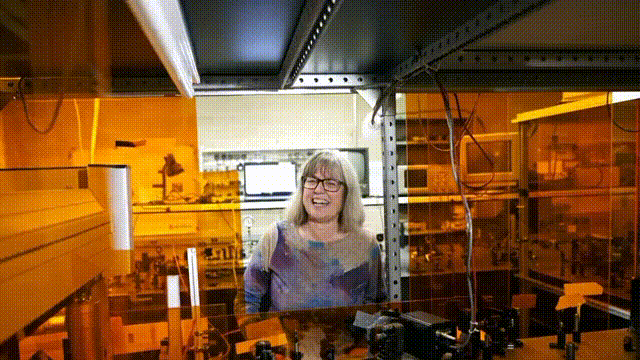
“
It is truly an amazing feeling when you know that you have built something that no one else ever has – and it actually works.
The laser, which was developed from the maser, (of no technological relation to the taser) came into this world in 1960. A laser is a beam of coherent concentrated light. While Hollywood was quick to imagine lasers powerful enough to blast aliens into pieces, the real world lagged behind. The first lasers were anemic, capable of scanning barcodes at the supermarket, but incapable of rendering Lucasean fantasies real.
Enter Donna Strickland, an optical physicist hailing from Guelph Ontario, working at the Laboratory for Laser Energetics at the University of Rochester. Dr. Strickland had come to the University of Rochester by way of the Guelph Collegiate Vocational Institute and McMaster University. As one of three women in her engineering physics class, she graduated with a Bachelor’s degree in 1981.
While working on her PhD in Rochester, she and her advisor, Gerard Mourou, developed a technique that allowed for an enormous increase in the power of lasers.
Any hockey player would be pleased to know that it involves chirping. Called chirped pulse amplification, the technique stretches, amplifies and then compresses a laser pulse. This procedure generates power levels that, if achieved with simple brute force amplification, would damage the laser itself. Lasers that were hundreds of thousands of times more powerful suddenly became possible.
With the practical implementation of chirped pulse amplification, laser’s accomplishments were no longer limited to scanning millions of peaches (not for free!) at the supermarket. Now they could be used to perform surgery on the eye and restore sight. Lasers could drill smaller and deeper holes in new materials, allowing new types of stents for heart disease to be manufactured. Scientists could peer deeper into the mysteries of the universe with these more powerful light sources. The accomplishments of the laser shone brightly.
Dr. Strickland worked at a number of different institutions before returning to Canada and the University of Waterloo in 1997. She joined as an associate professor, where she stayed without promotion, not because of sexism but because she never applied to be a full professor. Perhaps it was a professorial dislike of paperwork, perhaps because, in her words “I always felt as a woman, I could do whatever the heck I wanted”. And since she didn’t want to apply, she never did.
At Waterloo, she continued to advance the state of the art in her optical field. Laser pulses became ever shorter and more powerful under her watchful eye.
In 2018, Donna Strickland won the Nobel Prize with Gerard Mourou for their work on lasers. As when she graduated from McMaster with her undergrad, she became one of only three women to have ever won the Nobel Prize for Physics. And in a victory for professors everywhere, the University of Waterloo saw fit to promote her to full professor without her having to fill out the application.
Today, Dr Strickland’s work extends lasers to new wavelengths invisible to the human eye. Her recent discoveries in ultraviolet and infrared lasers will no doubt have their own transformative applications in the decades ahead. Who knows what vistas will be opened to humanity by her bright lights. We can be sure however, that Dr. Strickland and her students will have played an important role in building the way forward.
Image courtesy of Cole Burston

